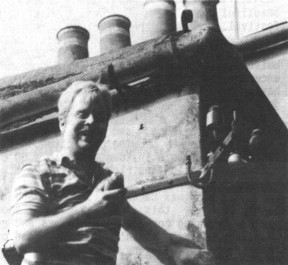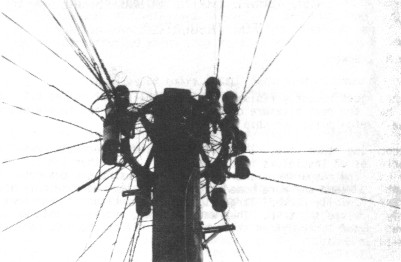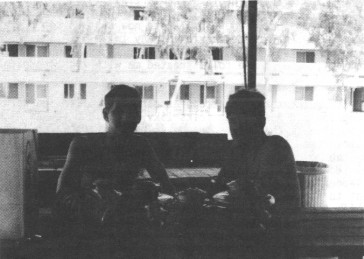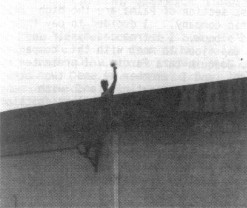All Ashore That's Going Ashore -- For Insulators
by Mike Bowen
Reprinted from "Crown Jewels of the Wire", November 1987, page 19
I have just recently finished a 4 year enlistment in the U.S. Navy, and I had
the real pleasure of collecting stories and insulators while in the foreign
ports our ship visited.
Recounting them now, I should have tried to get the many different varieties
of insulators that I saw, but I was rather limited on space in my berthing
compartment and I settled for just basic designs. I didn't want to send any more
home through the mail, because only 1 out of 5 (VERY carefully packed) large
high power insulators I sent home in early July survived the trip. They were
insured, but as of this writing, more than a year later, I am still being put
off by the U.S. mail system for re-imbursement.
My first insulator expedition to a foreign land was in Portsmouth, England.
The antique and junk dealers didn't seem to have any local market for glass
insulators, but one store owner suggested I "just have a walk around and if
I should find any not in use, why just take them." I mentioned this,
because I have never really looked anywhere other than shops or market places,
and with this thought in mind, I kept a close eye for some good glass on the
poles and buildings. I soon found a trio of porcelain insulators atop an old
English homestead that looked nice, and after asking permission of the owner and
explaining my hobby, scurried up the house and added my first three foreign
insulators to my meager collection. I had quite an audience while I was on the
gentleman's rooftop, as his neighbors from both sides and from across the street
watched, and afterwards listened to my informal stories on glass insulators.
That was a very pleasant adventure indeed!

First insulator nabbed by Mike Bowen
from an old English homestead in Portsmouth.

This picture shows what has to be a
lineman's nightmare in Portsmouth, England!!
My next stop was not until the next year, when our ship (my squadron was
aboard the U.S.S. America), set sail for a 6 month cruise in the Mediterranean
Sea. Our very first port visit, and I might add the most beautiful was Cannes,
France, host to the world-wise movie awards festival. Most of the buildings,
especially the newer sections of the city, were devoid of anything but the
present styles of electrical insulating material. A friend, Phil Holley and I,
walked to the less built up part of town, which yielded much in the glass
department. All except two homes had the insulators in inaccessible reaches.
After having a friendly chat with one young couple who spoke enough English to
get to (during which I traded a tour of our ship for 3 of the glass insulators
on their house), I climbed out on a upper balcony window, walked along a ledge,
and added three CD 781 ISOREX and L'ELECTRO VERRE insulators to my growing
collection. I had to pass up a real easy snatch off a pole in town that was a CD
827 ISOREX because the local "gendarme" station was right across the
street!
Our next stop was Catania, Sicily, and the U.S. Naval Air Station at
Sigonella. By this time, I had our shore patrol members from our squadron
looking for glass insulators and recounting their locations for me. The easiest
pickin's to date turned out to be a section of Catania called the
"gut," a very seedy place to be even in the daylight. I had to trade
my U.S.S. American ballcap for a group of 4 CD 800 MIVA in emerald and clear,
and I even tried to get a CD 802 ISOREX with one arm, but I was chased off the
roof by a rather nasty tempered old woman who apparently lived up there. The
next day, another friend, Gary Swope, and I, rode over to the N.A.S. Sigonella,
and I spoke at length to the Public Works people who were able to give me 5 high
power insulators (similar to a CD 968 SEDIVER, a CD 961 SEDIVER, one a CD 947,
and I can't remember the other two--only one of which survived the U.S. Mail!

Gary Swope and me relaxing at the base
at N.A.S. Sigonella with our high
power glass.

The roof top of the Public Works building in Sigonella was covered with
porcelain and glass of many manufacturers and sizes. Yep, that's me on the top
of the roof with a great green glass power piece! I regret that I couldn't carry
more of them back to the ship.
A port visit to Palma, Spain, was perhaps the most interesting and certainly
the most odd way to get insulators. Our squadron had a large party at one of the
hotels about 10 miles out of the city proper, and a few of the guys missed the
last bus back to the fleet landing. They decided to walk it, as it was a
beautiful night, and a quick rest stop in a large field at the edge of Palma
uncovered a dark green CD 154 E.S.A. I was given directions the next day as to
where it lay, and there I found it after only a few hours of walking and
looking.
Just down the street in the business section of Palma are the high rise
offices of the local gas and electric company. I decided to pay them a visit,
and armed with Milholland's book, I introduced myself and my interest. I was
escorted to the top floor to meet with the company's Vice President of
Operations, a Mr. Joaquin Lara Garcia. I presented my book as testament to the
interest, and I remember he and two other gentlemen leafed through it with much
fascination, and with many questions. Fortunately, Milholland's book has lots of
little tidbits of info within the covers. Mr. Garcia then took me on a tour of
their old power station and warehouse down the street, where I was able to get a
couple of insulators -- one of which is a porcelain version of a CD 804, no
markings, and the other an ice blue CD 828 A.V.1. on the front with E.S.A. on
the back. When we got back to Mr. Garcia's office, we passed a secretary's desk
and I noticed a green glass insulator holding a bunch of paper clips. I had
brought with me a CD 257 Hemingray-60 as a possible trade item, and sure enough,
I swapped it for an insulator that isn't listed in my copy of the Milholland's
book. It looks a little like a cross between a CD 220 and a CD 235. It's a light
green color with a number and E.S.A. on the front, and A.D.V.1. on the back.
I guess I should mention where the CD 257 came from that I had traded. I
purchased a number of insulators advertised in CROWN JEWELS OF THE WIRE (which
my wife sent to me while I was on board the U.S.S. AMERICA). Larry Veneziano,
one of your insulators now sits on top of desk in the office of the V.P. of the
electric company in Palma, Spain!! I also must add that I was the first American
ever to ask about insulators in their company, and these folks treated me with
much hospitality and kindness.
Our next stop was at the vacationer's paradise called Benidorm, Spain. Mainly
English and Australian folks like here, and it was nice to be able to converse
in the native tongue. The only insulator I was able to get (believe me, I tried
very hard, but the utilities companies are owned by the government) came from
the rooftop of an English pub, and after a friendly chat and a few native beers,
the owner provided me with a long ladder and let me climb up to unscrew a few
beauties. Two of them went to friends (one of which was sold at the Antique
Bottles and Collectibles Show held in Jacksonville, Florida, last October, where
I met Bob and Phoebe Adams) and I have one on my shelf. It's a CD 251.7 with
E.S.A. embossed on the front, in a very light green. This was the last insulator
I was to get from overseas ports because of the political tensions and
hostilities that followed our actions against Libya. I still have friends that
will be in my old squadron for a few years, so I will definitely place my order
for some more foreign goodies!!
|
